What if I told you we could have Galbi Jjim, Korean short ribs braised in a subtly sweet, garlicky, gingery soy based sauce that are so tender, they literally fall off the bone, but without the luxury price tag of short ribs? We're going to make Galbi Jjim-ish, Korean braised beef stew made with wallet-friendly chuck roast. Shall we?
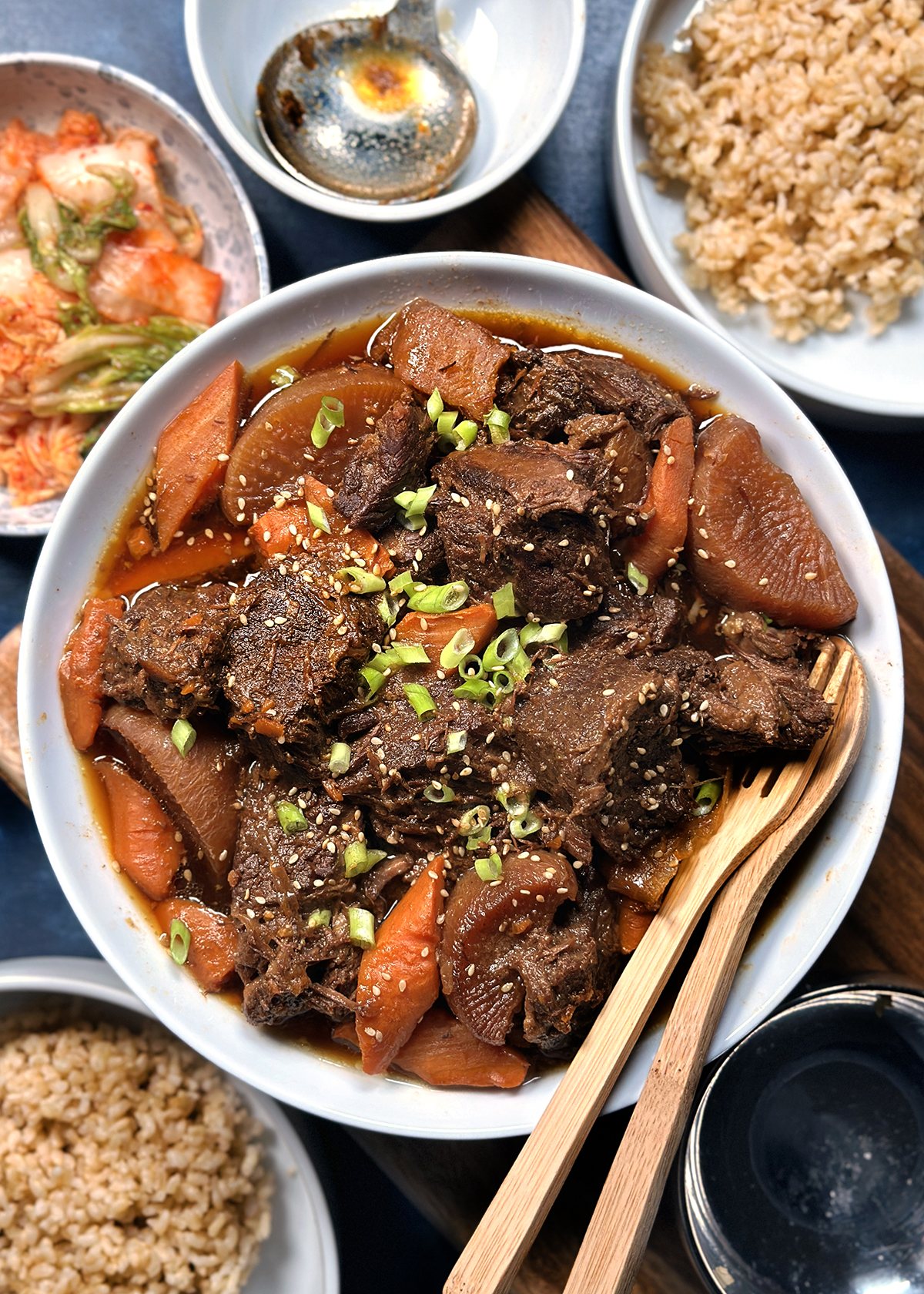
Jump to:
- What is Galbi Jjim-ish Korean Beef Stew
- Health and Dietary Considerations of Galbi Jjim-ish Korean Beef Stew
- Ingredients You Need for Galbi Jjim-ish Korean Beef Stew
- What Kind of Beef for Galbi Jjim-ish Korean Beef Stew?
- Instructions for How to Make Galbi Jjim-ish Korean Beef Stew
- How to Store Galbi Jjim-ish Korean Beef Stew
- FAQ
- Galbi Jjim-ish Korean Braised Beef Stew Recipe

What is Galbi Jjim-ish Korean Beef Stew
This Galbi Jjim-ish Korean Beef Stew is a dish of thick pieces of boneless beef braised in a subtly sweet, garlicky, gingery soy-based sauce, nearly identical to the braising sauce for Galbi Jjim, thus the name Galbi Jjim-ish. The low and slow cooking method renders the meat so soft and tender, you can literally shred it apart with a spoon.
The recipe here includes naturally sweet radish and carrots, and you can add other vegetables based on availability and your personal taste like potatoes, more onions, and squash.
Difference Between Galbi Jjim and this Galbi Jjim-ish Korean Beef Stew
If the braising sauce for Galbi Jjim-ish Korean Beef Stew is almost identical to the recipe for Galbi Jjim and they're both cooked low and slow, what makes the two dishes different? So glad you asked. It primarily has to do with the cut of beef.
Galbi Jjim is made of beef short ribs, and the dish is strinkingly presented with the bones intact. Beef short ribs are a chewier cut of meat than say, beef tenderloin and filet mignon, and were once considered more affordable. However, increasing popularity over the years along with the usual inflation and economic demands have now made short ribs a luxury ingredient that comes with a luxury price tag, especially if the short ribs are USDA prime grade! (expert source: United States Department of Agriculture)
On the other hand, Galbi Jjim-ish Korean Beef Stew is made of a more affordable cut of beef like chuck roast. The cut, which comes from a "working" region like the shoulder, has more connective tissue incorporated into the meat, which is what can make it tough if cooked incorrectly, but textured, soft, and rendered into viscous sauce when cooked low and slow.
Galbi Jjim is traditionally made and served on holidays like the Korean Harvest Festival known as Chuseok, Christmas Holidays, New Year’s, and special occasions and gatherings like family birthdays.
But why wait for special occasions? If you have the time, or a slow cooker or pressure cooker, Galbi Jjim-ish Korean Beef Stew is an "Any Weeknight" dinner.
I have made this dish so many times and it gets better and better each time!
Health and Dietary Considerations of Galbi Jjim-ish Korean Beef Stew
As printed, this Galbi Jjim-ish Korean Beef Stew recipe is:
- dairy-free
- gluten-free
- refined sugar-free
Beef from the chuck region can contribute to a lean protein-focused lifestyle. One 3-ounce portion of beef chuck roast has around 21 grams of protein. But since we know that an actual serving size is more like 6 ounces, chuck roast offers an average 42 grams of protein!

Ingredients You Need for Galbi Jjim-ish Korean Beef Stew
Galbi Jjim-ish Korean Beef Stew is essentially two types of ingredients: the chuck roast and vegetables together, and the braising liquid.
Here are the ingredients you need:
- Chuck roast or other beef stewing meat
- Shiitake mushrooms
- Korean or daikon radish
- Carrots
- Onions
- Garlic
- Ginger
- Green onions
- Asian pear
- Beef stock or broth
- Tamari or soy sauce
- Mirim (Korean version of Japanese cooking wine, mirin)
- Black pepper
- Sesame oil
The beauty of Galbi Jjim-ish Korean Beef Stew is that once you get the beef, the radish, and carrots down, you can add any other vegetable to the dish. Hearty root vegetables like potatoes and sweet potatoes are personal favorites, but I have made this dish many times even with not-so-obvious for stew vegetables like butternut squash, broccolini, kale, and baby bok choy.

Is There Sugar/Sweetener in Galbi Jjim and Korean Beef Stew?
There is no added refined sugar in this recipe, nor in most other Korean recipes on this site!
In this recipe for Galbi Jjim-ish Korean Beef Stew, subtle sweetness comes from grated Asian pear in the braising sauce, as well as in the carrots and radish. I prefer the lighter sweetness, the only downside is that the texture of the sauce is thinner and less "glossy" than sauces made with a lot of sugar.
If You Prefer a Sweeter Taste
Stir 2 tablespoons of honey or date molasses or maple syrup into the braising liquid when you first add the vegetables to the pot.
Sugar/Sweetness in Korean Food in General
If you eat or are familiar with Korean food, you know that Korean marinated meat dishes like galbi and bulgogi, whether grilled or braised or otherwise, can taste fairly sweet, and sometimes even veer into too sticky sweet. My family has always tended toward much less sweetness in Korean foods, and only add natural sweetness in the form of dried or fresh fruit as much as possible, and sometimes with maple syrup or honey.
What Kind of Beef for Galbi Jjim-ish Korean Beef Stew?
Instead of short ribs, we are using the more affordable chuck roast cut of beef for Galbi Jjim-ish Korean Beef Stew.
Chuck roast is a large cut of beef from the shoulder area of the animal. It has good beef flavor as well connective tissue that could normally make the beef a little tough to chew, but when slow cooked, breaks down and adds body and texture to both the meat as well as whatever sauce the meat is braised in. Like short ribs, chuck roast has a good amount of fat marbling, which is what carries flavor and tenderness.
Buy chuck roast as the large whole "roast" without the bone if possible, then cut the larger roast into stew-sized pieces yourself at home, or have the butcher do it for you while you're there. I recommend buying the larger roast size rather than pre-cut and packaged "beef stew meat" pieces because you know exactly what cut of meat you're getting, and can cut the pieces to the size you like, which is probably much larger than the little pre-cut cubes.
Pro-tip: Normally, I recommend against buying meat from Costco** because of the way high-volume production increases the chance of food-borne illness. However, because we cook the beef until completely well-done rather than seared fast and furious on high heat to only medium, there is much less risk of food-borne illness. So in the case of prime-grade beef, Costco offers an unbeatable price and I say go get that bulk discount!
** I am highly in favor of buying almost anything and everything else at Costco!
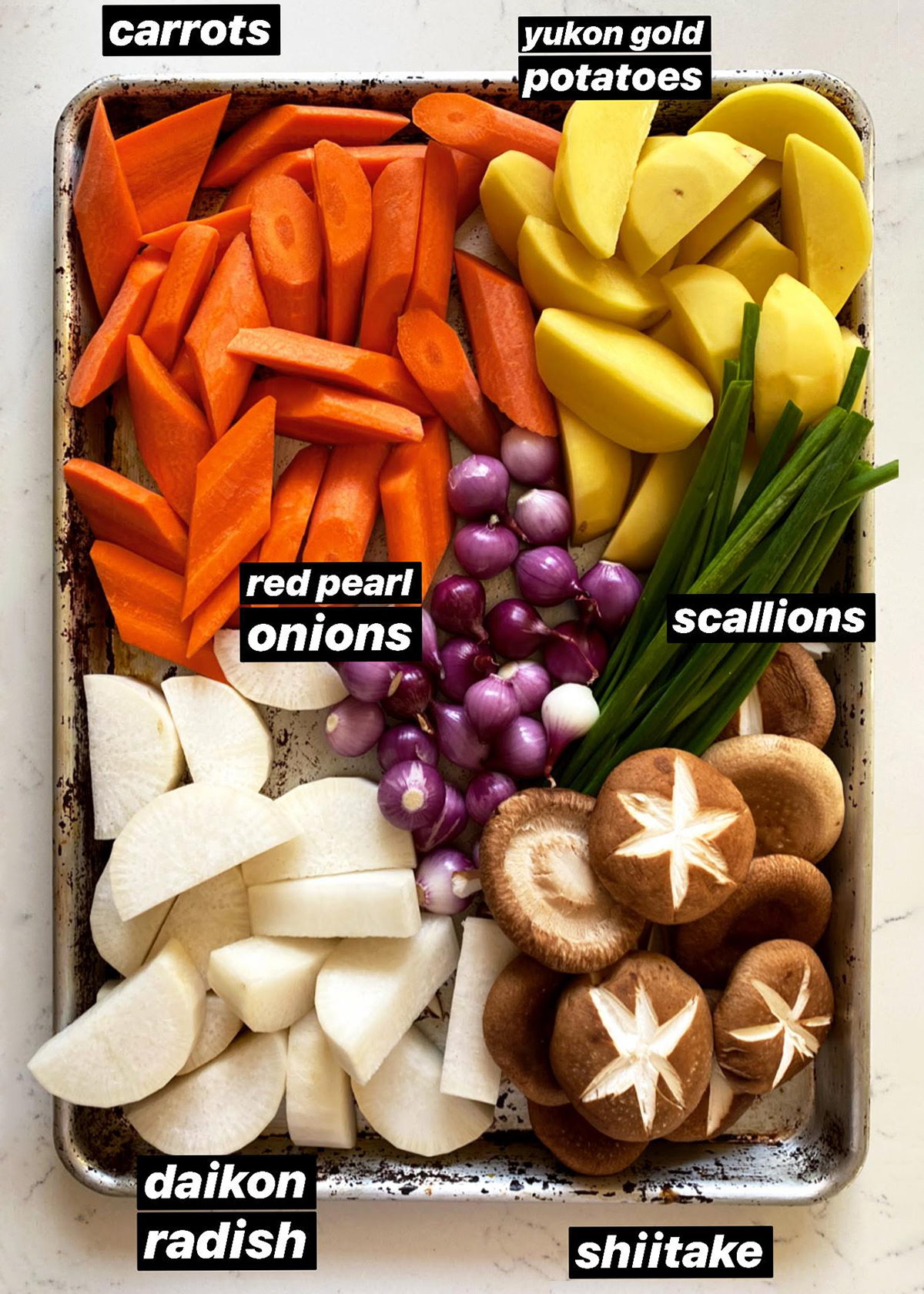
Additional Ingredients Notes and Resources
Korean radish, called "mu" or "moo," is a large white radish that has a light green top near the stem. It is similar to Japanese daikon radish, though it is bigger, sometimes 5-inches in diameter! I have only ever found Korean radish at Asian grocery stores.
Asian pear. Pear is crucial as it not only adds natural sweetness to the sauce, but more importantly, it tenderizes the meat! These are 3- to 4-inch diameter, softball sized round, tan pears. Asian pears are increasingly available at regular grocery stores, and different varieties are called Butterscotch pears, Shingo pears, or specifically Korean pears.
Tamari or soy sauce. Tamari is Japanese soy sauce. Unlike regular soy sauce which has wheat, tamari has little or no wheat. Therefore, tamari can be gluten-free, though not always, so if you eat gluten-free, make sure to read labels. I use this organic gluten-free tamari. This brand is also great, though might be a little harder to find in-store.
Mirim. 미림, mirim, is the Korean version of Japanese cooking wine known as mirin. You can use either sake, which is Japanese rice wine, or mirin, Japanese rice wine that is naturally sweet and seasoned. Make sure to use mirin and not aji-mirin, and read the label to make sure there is no added sugar or corn syrup.
Sesame oil. Use toasted, not regular, sesame oil. Regular sesame oil is golden in color. Toasted sesame oil, on the other hand, is dark brown and is used as a finishing oil, not as a cooking oil. This is the Japanese brand that everyone and their mothers' have been using for years. You can usually find organic like this one in natural and higher end grocery stores.
All other produce from the regular grocery store or farmers markets.

Instructions for How to Make Galbi Jjim-ish Korean Beef Stew
Galbi Jjim-ish Korean Beef Stew is fairly straight-forward to make. You literally put everything in a large pot, bring to boil, then simmer for hours until the meat is so tender it can shred apart with a spoon. The "hardest" part of the recipe is just the amount of non-active time you just let the stew simmer.
Here are the high-level steps to make a gloriously rich, tender Galbi Jjim-ish Korean Beef Stew:

Prepare the Braising Sauce. Combine the tamari/soy sauce, mirin, grated Asian pear, garlic, grated onion, and black pepper.

Braise Beef. Place beef along with all of the braising liquid in a large heavy bottom pot or Dutch oven.

Add ginger pieces to pot and shimmy them under and between pieces of beef. Add broth or pre-made stock so that the beef is submerged with about ½-inch sticking above the liquid. Bring to boil, then reduce heat, cover and simmer for 1 hour. Every once in a while, give the beef pieces a gentle stir to make sure all sides are getting covered with the braising liquid.

Prep Vegetables. While the beef is braising, prep the carrots, daikon radish, mushrooms, and any other heavy, starchy vegetables you might be using. (Note: the phot above doesn't show mushrooms because on this go 'round, I didn't have them on hand.)
Braise

After the beef has been braising for 1 hour, add vegetables to pot with beef, doing your best to shimmy the vegetables between the pieces of beef and into the braising liquid.

Cover, bring back to boil, reduce heat and simmer until the vegetables are fork-tender and beef shreds apart, at least 45 minutes and up to 1 hour. Periodically, turn the beef and vegetables over and ladle the braising liquid over the beef and vegetables.
Technically at this point, you can serve and eat the Galbi Jjimiish Korean Beef Stew. However, if you have the time, the next few steps of straning and defatting the braising sauce are definitely worth it!
Strain and De-Fat Braising Sauce

Once beef is shreddably tender, remove the beef and vegetables from the pot to a separate bowl or storage container.

Strain the braising liquid through a mesh sieve into a heat-proof container, preferably something a little taller and narrower rather than a wider, shllower bowl. Press down on the solids to extract as much of the liquid as possible. Discard the solids.
Straining the braising sauce is OPTIONAL, but if you choose to leave the braising sauce as is, make sure to at least fish out the large pieces of ginger!
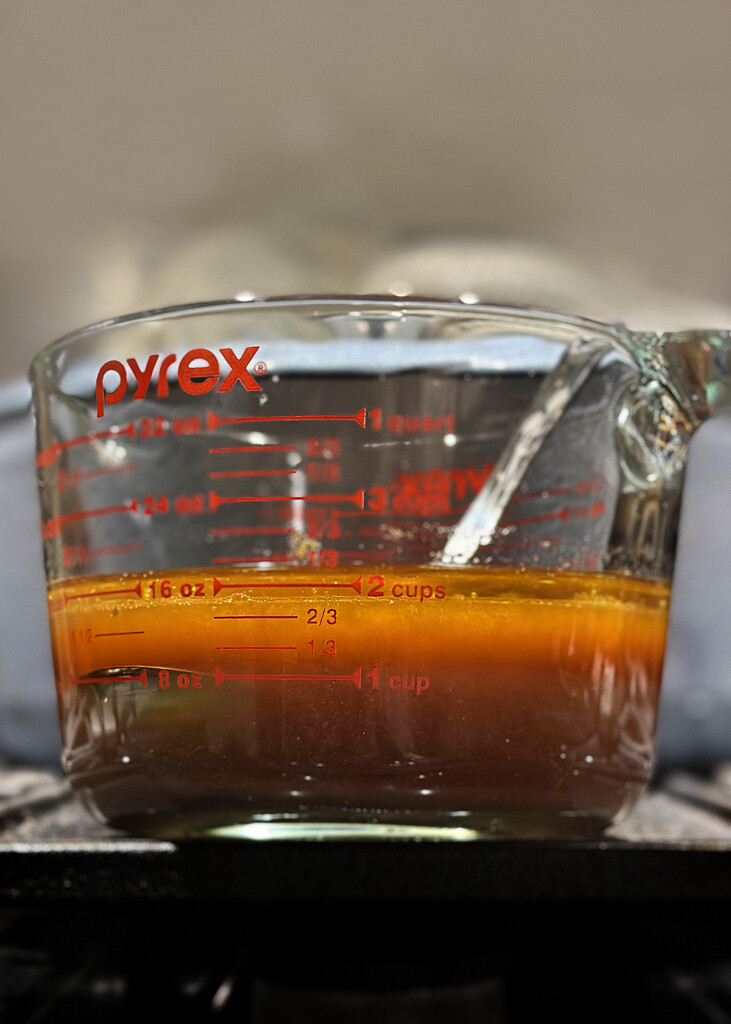
Place the strained braising liquid, covered, in the refrigerator overnight.

Remove the chilled braising liquid from the refrigerator. The rendered fat will have risen to the top and solidified.

Remove the solidified fat from the braising liquid and discard the fat. Do not throw the fat down the kitchen sink drain.

Place the beef, vegetables, and strained braising liquid in a pot and reheat gently over medium heat.
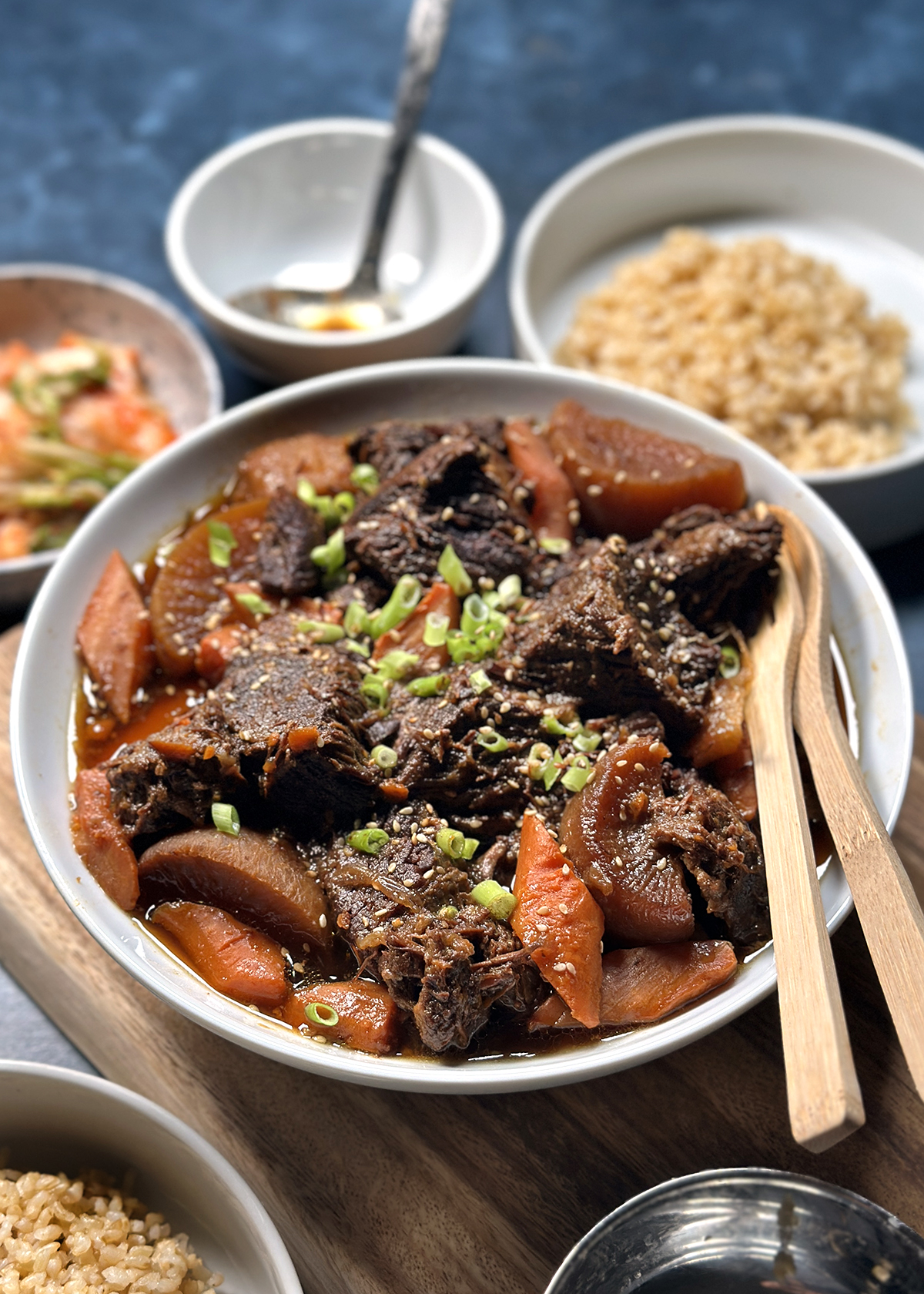
Garnish with sliced green onions, toasted sesame seeds, and a drizzle of toasted sesame oil if using.
If storing, portion the beef and vegetables into air-tight storage containers, cover with braising liquid, and store.
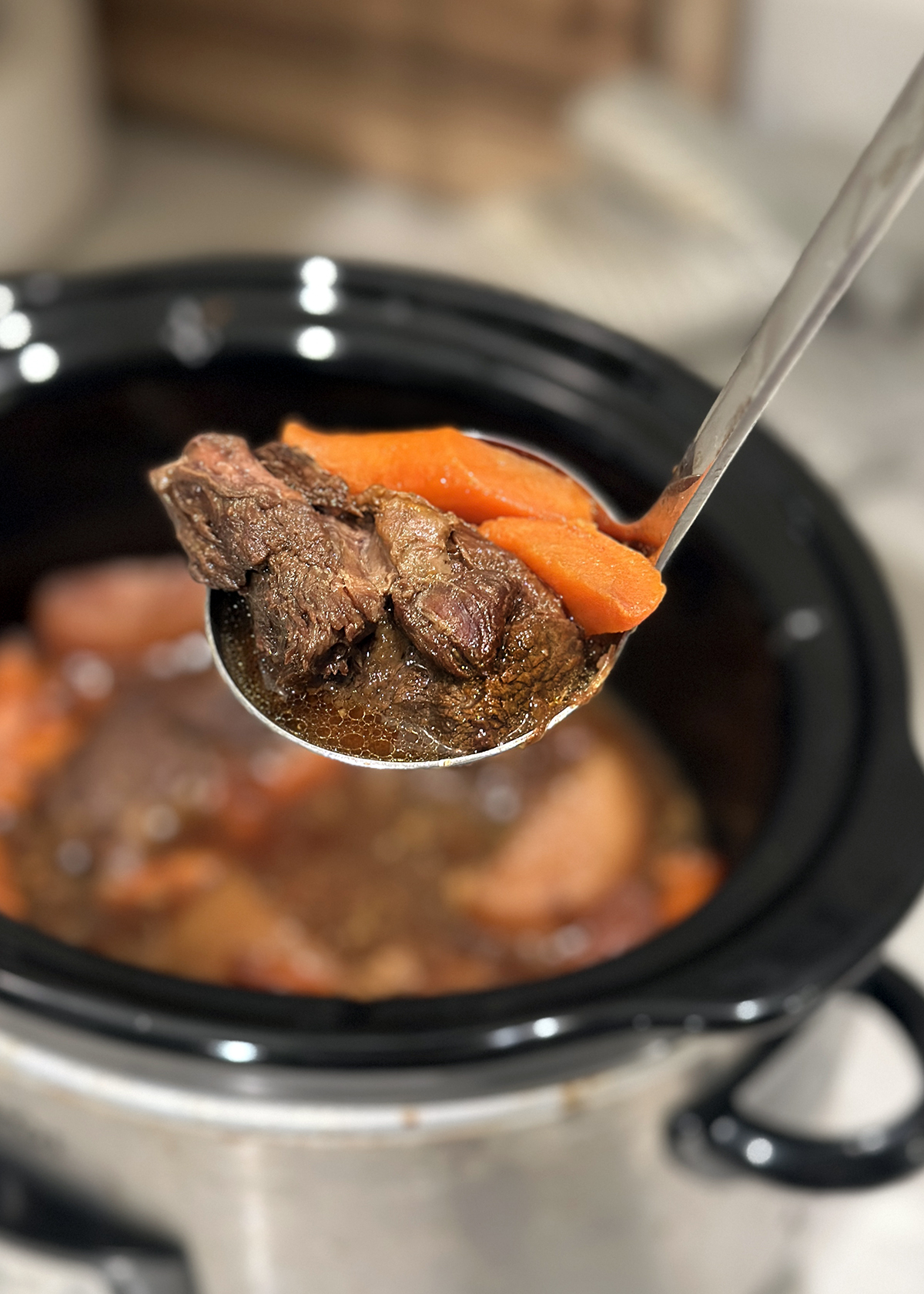
How to Make Galbi Jjim-ish Korean Beef Stew in a Slow Cooker
This recipe is MADE to be made in a slow cooker or crock pot!
Toss the chuck roast pieces and braising liquid into a minimum 6-quart slow cooker, add enough broth or stock to submerge the beef, then cook on high for 4 hours or low for 8 hours. When there is 1 hour left on the slow cooker, add the cut vegetables and continue cooking until complete.
When ready to serve, remove the beef and vegetables to a serving platter. Follow the instructions above to Strain and De-fat Braising Sauce through a fine mesh sieve, cooling, and discarding solidfied fat.
Pro Tips and Techniques
- Cook in advance. If you do have the foresight and time to cook in advance, make the recipe at least 1 day in advance. The flavor will deepen, the beef will be more tender, and the solidified fat will be easier to remove. See detailed notes about Advance Cooking below.
- Use the widest pot you have to give as much room to the beef and vegetables to spread out into the braising liquid, rather than stacking up on top of each other. This will especially help the vegetables stay intact.
- Simmer, not boil. Because beef stew is braised, the cooking temperature has to be very low. Except for the initial boil to get the pot up to temperature, maintain the temperature at a very gentle simmer. You simply cannot turn up the heat and boil it to make it faster. The whole point of a braise is to cook on low heat, over a long period of time to breakdown the collagen and fibers to make the meat super tender.
- Remove vegetables when they are tender, which may be earlier than the beef is ready. If the beef still needs more cooking time, but the vegetables are already tender, remove the vegetables from the pot with a slotted spoon or tongs and set them aside until the beef is ready. If you leave the vegetables to cook for too long, they will break down too much.
Can You Cook Galbi Jjim-ish Korean Beef Stew in Advance?
Yes! You can and absolutely should cook this Galbi Jjim-ish Korean Beef Stew in advance! Beef stew of any kind is actually better if you make it one or two days in advance, which is partially why it's such a great dish for meal prep or for a larger gathering.
Not only are you able to more easily remove rendered fat, but the short rib meat becomes even more tender after it cools then re-heats.
Cook the recipe as directed, then follow these steps to store in refrigerator for up to three days:
- Remove fully cooked beef and vegetables from the braising liquid in the pot to a storage container, cover and refrigerate.
- Strain braising liquid through sieve as directed into a tall, narrow storage container. Discard solid bits in sieve. Cover strained braising liquid and refrigerate overnight.
- The following day, all of the rendered fat from the short ribs will have risen to the top of the braising liquid and solidified. Using a fork or spoon, carefully lift off the solidified fat and discard in the trash. Do not discard the solid fat down the kitchen sink drain.
To re-heat, place the beef, vegetables and braising liquid in a pot, bring to a boil, turn down heat and simmer for 10 minutes. Garnish and serve immediately.
How to Store Galbi Jjim-ish Korean Beef Stew
Refrigerator. You can keep Galbi Jjim-ish Korean Beef Stew in the refrigerator for 3 days. After the rendered fat has been discarded, you can store it in its own braising liquid. I like to use large mason jars with sealing plastic lids.
Freezer. You can freeze Galbi Jjim-ish Korean Beef Stew for about 3 months. After the rendered fat has been discarded, you can storeGalbi Jjim-ish Korean Beef Stew in its own braising liquid, which will keep the meat and vegetables from drying out. The way that works best for how I maintain my freezer is portioning the Galbi Jjim-ish Korean Beef Stew directly into freezer-safe quart-sized bags, squeezing out all the air, sealing, and laying flat in the freezer until it freezes. Then I stand the bag or multiple bags up and line them up like thin books on a bookshelf. If you're looking to reduce single-use plastic, these are re-usable ziptop bags.

Ingredient Substitutions and Variations
Here are a few suggested substitutions for some of the slightly harder-to-find ingredients, as well as suggested additions, and variations. I have tried all of these and the family truly does love all of them!
Dried Shiitake Mushrooms for Fresh. If you want to use dried shiitake mushrooms, soak dried shiitake mushrooms in hot water for 30 minutes to 1 hour, while the short ribs are braising.
Pears or Other Fruit. If you can't find Asian or Korean pears, you can use regular pear. If pears are out of season, use 1 cup chopped kiwi, which has similar compounds that can naturally tenderize meat.
No Tamari. Substitute with regular soy sauce.
No Mirim/Mirin. Substitute with sake, Japanese rice wine, in the equivalent amount. If you don't want to use alcohol, you can leave this out completely.
Suggested Additions and Variations
Add 1-2 cups of any of the following vegetables cut into 1-inch pieces along with carrots and daikon:
- white potatoes
- sweet potatoes
- pearl onions instead of sliced regular onions
- butternut squash or kabocha squash.
Make it Spicy Korean Beef Stew by stirring 1 tablespoon of gochugaru plus 1 tablespoon gochujang into the braising sauce when you first add the vegetables to the pot. Add more of either or both ingredients to make it even spicier!
Tools and Equipment
- Dutch Oven. This is the large, oval Dutch oven I use for braising.
- Stock Pot: If you want a slightly lighter weight pot, I like this very large stock pot by this cookware company. It has a heavy bottom and easy-to-hold handles. Any large pot that fits the ingredients will do.
- Slow Cooker: I have this 6-quart programmable slow cooker. If you are going to use a slow-cooker, I highly recommend getting/using a slow-cooker that has a timer or auto-shut-off so you can truly "set it, and forget it," which is kind of the point of a slow-cooker, imho.
- Stainless steel tongs
- Strainer
- Large bowls, one that fits within the other. I use both stainless steel and glass mixing bowls.
- Thermometer
- Quart sized mason jars
- Plastic sealing lids for jars. Get rid of those annoying two-piece metal lids that come with mason jars (unless you're doing actual canning) and get wide-mouth lids for the larger jars, and wide-mouth smaller jars
- Plastic storage containers: I keep a decent supply of these plastic quart (32 ounces) containers for any- and everything. The containers are technically "disposable," but they can be used a few times with hand-washing between uses. The best thing, though, is freezer-safe glass. Always make sure the stock is cool before pouring into any type of storage container.
- Large format ice cube trays. If you plan to make and freeze bone borth for the rest of your life, these "souper cube" trays specifically dedicated to broths and soups are great to have.

What to Serve with Galbi Jjim-ish Korean Beef Stew
Korean Beef Stew is technically a one-pot meal, so you don't really need anything else to serve and eat with it. However, it wouldn't be a Korean dish if you didn't serve fluffy steamed rice and some kind of kimchi along with it. Ladle big tender, falling-apart hunks of Korean Beef Stew over a bowl of rice that will soak up the juices, and serve with any of these alongside:
- Oi Muchim, Korean Spicy Cucumbers
- Spicy Cucumber Salad with Avocado
- Din Tai Fung Dupe Cucumbers
- Korean Sesame Spinach


FAQ
Use whole chuck roast for Galbi Jjim-ish Korean Beef Stew. You can also use a fatty cut of brisket. Short Ribs are technically a great cut of beef for braising and stewing and have their own Galbi Jjim recipe here!
I generally estimate ½ to ¾ pound of beef per person. If in doubt on the err on the side of more, and freeze leftovers. You future busy self will thank you.
Older recipes for braised meats start with soaking meat in cold water for a few hours, even overnight, changing out the water every 30 minutes. The reason for this step was to extract red "bloody" juices and game-y flavor from the meat. This may have been necessary a long time ago when meat might not have been as fresh or not quite as high in quality. However, these days, we're using fresher, higher quality meat so we don't need to soak the meat.
A: Yes, you can skip the step of straining the braising liquid and discarding the solids! If you truly are pressed for time, leaving the braising liquid as is won't taste bad. But it won't taste great either. Just make sure to at the very least pull out the pieces of ginger, which is somewhat unpleasant if someone bites into it because it's tough and fibrous.
More Korean Main Dishes
Galbi Jjim-ish Korean Braised Beef Stew Recipe
Ingredients
Braising Sauce Ingredients
- ½ cup soy sauce
- 2 tablespoons mirin
- ½ medium Asian pear, grated
- 10 cloves garlic finely chopped
- 3 slices fresh ginger
- ½ teaspoon black pepper
- ½ regular onion, grated
Galbi Jjim-ish Beef Stew Ingredients
- 5 pounds chuck roast, cut into 2-inch pieces
- 3 carrots, peeled and cut into 2-inch pieces
- 1 large onion sliced into ½-inch wide slices
- 1 cup daikon radish sliced into 1-inch rounds
- 5-6 whole peeled cloves garlic lightly smashed
Finishing Ingredients/Garnish
- 1 green onion, sliced on a deep bias
- 1 tablespoon toasted sesame seeds
- 2 tablespoons toasted sesame oil
Instructions
Braise Beef : Cook Time ~ 1 to 1½ hours
- Combine all of the Braising Sauce ingredients—½ cup soy sauce, 2 tablespoons mirin, grated Asian pear, garlic, ginger, grated onion, and black pepper-in a bowl or measuring cup.
- Place beef chuck roast pieces in a large, heavy bottom pot or Dutch oven. Pour Braising Sauce over the beef, then add 1-3 cups broth or stock to bring the liquid to just below the top of the beef. Bury the ginger between the beef pieces.
- Bring beef and sauce to a boil, then reduce heat to low, cover with lid with a slight vent for steam, and simmer for about 1 hour. Every once in a while, ladle some of the braising liquid over the top of the ribs. If the liquid gets low, add more broth, stock or water, and make sure the heat is turned all the way down.
Braise Stew with Vegetables
- After 1 hour, add to the pot: 3-4 peeled carrots cut into 2" pieces, daikon radish cut into 1-inch cubes, sliced onions, and any other vegetables you would like to use. Carefully try to nestle the vegetables bewteen the beef pieces and into the braising sauce.
- Bring contents of pot to a boil again, cover, then reduce heat to low and simmer everything for another 45 minutes to an hour, or until the meat is tender. You can check this by sticking a fork into the meat.
- If the vegetables cook faster and are finished before the beef is tender, gently remove the vegetables to a seaprate bowl or container, cover and set aside while the beef continues cooking. Add the vegetables back to the pot just before serving to warm the vegetables.
- Garnish with sliced green onions and toasted sesame seeds. Drizzle with sesame oil if using.
Notes
Afterthoughts
It took me less than a week to devour Freakonomics.
Freakonomics is not the latest kid-focused brand born out of the brilliant cereal-marketing minds in Battle Creek, though don’t worry, I could have made that mistake at first, too. It’s a book that everyone, and I mean everyone, else has already read. And though I am always the last one, I read it in the equivalent of probably 12 hours, spread over 7 days so I’m all caught up!
I read Freakonomics for a few reasons: 1) I’m a freak, 2) I’ve gotten strange looks when people find out that I read cookbooks in bed before going to sleep, and 3) I studied economics in college and learned absolutely nothing valuable from comparisons of government spending on guns vs. butter and why firms supposedly set their prices where marginal cost equals marginal revenue (MC=MR). Somebody, please! Teach me something so that since my Economics degree can’t get me a job, I don’t feel I’ve completely wasted my (parents’) money on college tuition!
Now, I’m not going to say that I loved the book, but it was interesting and very well-written, which made it easy and fast to read. Because I have the attention span of a Cuisinart and the need for a sense of accomplishment through task-completion, easy and fast (oh dear, am I channelling RR today?) are good things (no, I believe it’s Martha).
In case you are one of the now six people who have not yet read Freakonomics, I’m going to tell you what the book is about, but in a much less sexy, much less book-sellingish way than the author’s publicist has done.
Read 'Em and Weep
Economic analysis, especially from a buttoned-up, tweed-jacketed University of Chicago-trained economist, sounds dry and esoteric, but remember that the title of the book is Freakonomics.
(By the way, I have nothing against Chicago – I almost went there for grad school before I realized that I’d slowly but surely freeze my prissy LA ass off, but I do have something against economists. I *ahem* dated one, and boy, was that as fun as a semester of Game Theory.)
This young whippersnapper of an economist, Steven Levitt, simply leans back in his Herman Miller, starts stroking his hairless chin, and after what could only be explained by a few hits off the bong that he hides in the bottom drawer of his desk, curiously asks questions of totally non-economics phenomena, sometimes juxtaposing seemingly unrelated, every-day scenarios and people like sumo wrestlers and school teachers (though that may not be so random if he actually met my 6th grade History teacher).
Levitt starts each chapter with one of these bizarre questions that he has hackingly coughed out of his mystical lungs. Then, in a brilliant slow motion wafting and containment of smoke into facts and figures, he gels together a clear, sharp, and very entertaining economic analysis. And when once 30 pages earlier you doubted if he could logically and believably prove that Real-Estate Agents are like the Ku Klux Klan (without having actually tried to purchase a home in LA), you find yourself understanding that everything can, indeed, be explained with fundamental economic principles, models, and tools like incentives and information (im)balances. You just have to be brave enough to challenge conventional wisdom and know what to measure.
No Parental Controls Recommended
The last two chapters of the book, Five and Six have to do with parenting. For some reason, as much as the in-depth investigation of the crack dens of Chicago was an interesting explanation of why drug dealers, who were previously believed to be fur-lapelled floor-length leather coat-wearing, gold chain bling-dripping pimps, actually still live with their moms, these last two chapters are absolutely the most intriguing of the entire book.
My fascination with the chapter "What Makes a Perfect Parent?" has to do with the fact that my sister is now a parent. I love telling her that Freakonomics says that it does not matter what she does as a parent because her daughter, my niece, will do no better nor worse in life based on my sister’s “parenting techniques.”
Levitt uses standardized test scores as an indicator of success.
By pitting conventional parenting factors against one another, he determines that things like whether you work or stay at home with her during the so-called “formative” years, whether you “culture” her by taking her to museums, whether you spank her or not, allow her to watch tv or not, or read Goodnight Moon to her every night or not, do not correlate at all with children’s test scores, and thus have no effect on a child’s future.
No effect. None. Ultimately, Levitt’s conclusion is that a “perfect parent” as measured by standardized test scores, is not determined by what parents do, but who they are.
*whoa*
That could seriously injure the sales on a lot of “parenting” experts’ books out there!
And I’m about to completely kill all sales of these books based on conventional parenting by showing you some living proof. Case in point: One vicious Delicious Sarah.
Here's the Beef
My mom never slow-cooked a homemade beef stew for our family when we were little. In fact, she didn’t make too many of any of the classic "American" dishes—meatloaf, mashed potatoes, tuna noodle casserole. It was a very special occasion when we ate "American" foods like spaghetti or steak. Is spaghetti an American food? In the Delicious house, if it wasn’t Korean, Chinese or Japanese, then it was “American,” even linguine alla vongole that Mom made from Campbell’s Clam Chowder.
With the exception of steaks that were sauteed in a frying pan and eventually just doused with soy sauce and sesame oil just like galbee anyway, all of the “American” things we ate weren’t quite homemade. It wasn’t that my Mom was a flutz in the kitchen. Mom is a wizard with Asian foods. It’s just that Mom had more exciting things to do with her life like winning golf and tennis tournaments than to spend time poring over cookbooks in search of a recipe for the perfect baked macaroni and cheese. By the way, if it means anything to anyone, Mom still plays and sweeps the local tourneys. I just have to ignore her visor-slash-inverted-satellite-dish and it’s all good.
Things like beef stew never made it to our table unless it came from a box in the freezer or a can. We knew it would be a special "American" night in the Delicious household when, at 5:00 PM, we heard the whirr-buzz of our electric Black & Decker can opener that ended with a final vacuum-pack-releasing schloop of suspiciously realistic meat product not too unlike Alpo, mixed with incredibly perfect cubes of potatoes and carrots into a microwave-safe dish. And still, we ate our Dinty Moore beef stew with rice and kmchi.
What the Foie
Now if Mr. Levitt were incorrect in his economically analyzed conclusion about future-affecting factors and if the conventional wisdom about parenting, i.e. your actions as a parent do matter, were in fact true, then it would be logical to assume that I would be in a trailer park somewhere in the backwoods of Ohio eating Spam and barking like a jindo.
But that’s not the case.
Let it be known that I bark like a poodle!
What it all boils down to—pun intended!—is that if you feed your children trailer trash canned cuisine like Hormel Corned Beef Hash, you are not somehow vacuum-sealing their Spam-tastic fate.
Conversely, it doesn’t matter if you feed your children foie gras and caviar in hopes that they will go on to live a lifestyle of the rich and famous, and presumably take care of you in your old age in their Bel-Air mansion with live-in nurses instead of sticking you in some sorry-ass nursing home. It only matters that you do feed your children, and that you do it because you love them. Levitt says that “the things that matter were decided long ago,” factors over which you have very little control.
So whether parents feed their daughter truffled scrambled eggs with pancetta-wrapped dates, or Dinty Moore Beef Stew with kimchee and goh-choo-jahng, will have no effect because if it’s in her, she’s going to end up as fanatical Ms. Freaky F. Freakalicious food freak who slow-cooks beef stew without a pressure cooker, from scratch, and immediately blogs about it. No matter what.
And for the record, I do not now, and have never, not since my childhood, ever liked duck liver. Ever.
I love caviar though.






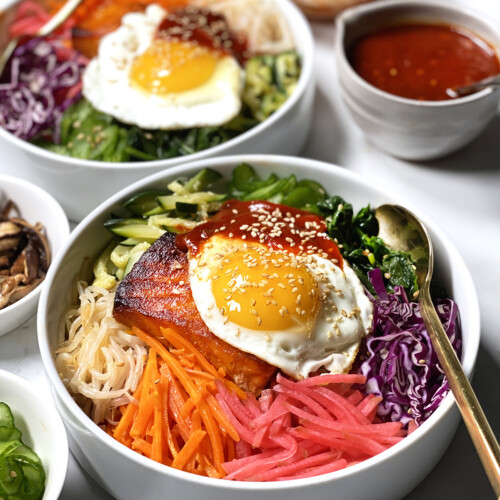
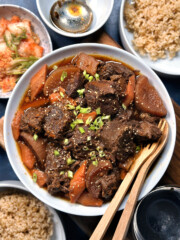




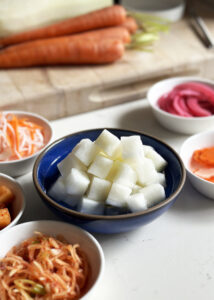

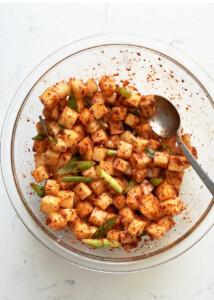
Maure says
I'm looking forward to this blog sarah. I too have very specific childhood memories of Dinty's beef stew.
Summertime visits to my grandmother in Indio inevitably
resulted in a weeks diet of Dinty's and corned beef hash - eaten in a quite-cluttered, un-airconditioned kitchen with black
widow spiders lurking just outside.
The stew looked nothing like the
photo on the label - and the taste:
Well, wouldn't even make it into the "Gulag cooking for dummies" edition. no moore dinty's for me.
Tony of Bachelor Cooking says
a nasty pop up-floating ad covered the pic..
But the pic is nice dinty or not
Rose says
I actually meet Mr. Levitt--more specifically I went to a private brown bag lunch event where he was discussing his research on drug dealing hiearchies. His work is pretty fascinating when he explains it in person--very engaging speaker and discussant--really likes students, which cannot be said of other professors I have meet. I haven't read Freakonomics yet, it's one of those books that sits on the upper tier of my book wish list.
His main research areas used to be about the economics of drug dealing, though I think he's added new interests into the mix. That's probably why he spends so much time on the subject in the book.
My friends and I were discussing beef stew just the other night. One of them said her mom couldn't make much of anything good, but her beef stew was amazing. It's definitely a dish I can pine for in this g-d forsaken weather we're having in the east.
Have you ever tried adding five spice to your stews? My mom does that, very asian, really nice touch, too.
Robyn says
I LOVE BEEF STEW! My mum never made it from scratch but...yeah, we got Dinty Moore. From Costco or BJs.
Mmmmm.
My mum didn't make any classic American dishes (as for what she did make...um...I guess Chinese-ish stuff). I think we had mashed potatoes when I decided I wanted it for Thanksgiving, the uber-American holiday. I love mashed taters, yes.
I'm not a fan of fish eggs. Meh.
Swati says
Dear S,
I live in India, so, what is beef stew? Would you rate it higher than a chicken soup for the soul?
Is there a lot of esoteric stuff in the economy of drugs? It is just that someone somewhere makes a littlebit/a lot of money. Think of cigerette sales. Nicotine also kills but it is sort of legalised.
Here in India, it seems that every cool student smokes marijuana! It forms a part of rituals of some sects. So, I guess it is quite widely available and affordable. It is the designer drug scene in India that is aimed at the well-healed.
Talking of fish roe, the raw stuff has to be mixed with finely sliced onions, ditto garlic and green chillies, salt to taste and a pinch of flour to provide a binder. It has to be deep fried in mustard oil, a very very bengali thing. To be eaten with plain boiled rice and mussoor dal.
The above is plain home cooking and cannot be obtained for love or money in any Indian restaurant.
Can't you make friends with some Indian mom? Just for the home cooking? You might even come to adore cilantro-- dhania patta in North India.
When you can, come to India to eat. Try our regional stuff. On the other hand, thanks to oodles of my countrymen flooding the silicon valley, I am sure all this exists around the corner from you. You just need a guide, nay a guru to guide you through.
sarah says
maure: funny, i always found it slightly disconcerting that the vegetables were SO perfectly shaped and SO brightly colored. that can't be natural. LOL!
tony: hm, i'm going ot have to check out why there are pop-ups coming from this site...
rose: what a great idea about adding the five spice! i think as the days get warmer, the beef stew nights will be fewer and far between, but next time, i will definitely do some experimentation.
robyn: haha! yes, i think thanksgiving was the ONE day, when we were little, that we had MAYBE a few things that were a little more "American," but even then, we still ate turkey with rice and kimchee. :)
swati : i DREAM about making a food vacation trip to india! i am quite certain that i would have the TIME of my life! until then, i have to rely on many of the restaurants here in l.a., and hopefully, this year, i will actually try my hand at making some of my favorites in my own kitchen...well, i guess more than anything, i just want to try making naan :)
Sarah B. says
Sarah,
I have been reading your wonderful blog for about 5 months now. I'm a Korean American undergrad at the U of C and I just had to say something since you mentioned the Levitt :-)
I love your blog~
You are sassy!
I'm also a,
Sarah
Grace says
I thought I was the only person putting their econ degree to great use reading food magazines, cookbooks, and food blogs before bedtime.
Not only did "american" food nights include the aforementioned spaghetti with clam chowder, we also had ribs made with Lee Kum Kee chinese "bbq" sauce and after much begging, we finally had turkey for Thanksgiving which my mom then basted with soy sauce and served with rice.
Love your blog.
sarah says
sarah b: you are at chicago! awesome! ar you freezing to death? lol! my friends on the east coast and midwest always think it's weird that i ask that, as if it's any different last winter, this winter, or next winter. :) and thanks for the love...
grace: lol! well, i think we had regular turkey for thanksgiving, but we most certainly did have rice, and kimchee. in fact, now that i think about it, i am not sure we had too many other typical American side dishes. we had bahn chan. LOL!
hermz says
I've read a book full of data showing the same thing... parenting doesn't do a whole lot. It was a book about genetics and the mind, so it went further and looked at other studies (identical twins, fraternal twins, siblings raised in differnt homes, etc. are great sources of info). It looks like who we are is determined at least 50% by genetics... some argue up to 70%. The rest is believed to depend upon with whom we socialize as children, i.e., what roles we assumed when with children our own age. Interesting stuff.
sarah says
but isn't it also genetics that would determine what kind of roles we choose when we are with other children? i.e. a very bossy dominant "leader" child on the playground probably takes on that role because she just IS that way. so, in essence, it's ALL genetics.
great. no wonder my dad taught me the rule of 72 and made me read the wsj when i was five and now i read my 3 month old niece the joy of cooking. LOL!
Megancake says
I really enjoyed the book as well and I found what he said on parenting to be very interesting. I agree with you that feeding your kids certain foods with the hope that it will somehow affect their future is stupid. However, I know that feeding your kids junk at a young age makes them more prone to continue eating junk as they become adults and sets them up for an unhealthy relationship with food. Also, I read that kids develop their taste buds by age 2, and so it seems to me that people should expose their kids to different tastes by then if they want them to eat those foods a few years later. The boy I nanny for was given all kinds of foods as a baby, including spicy stuff, now he eats anything! he isn't picky and it makes my like a lot easier. Where as his sister, who had a different caregiver when she was an infant, was not exposed to any of those more exotic flavors and is now such a picky eater. Of course this is just one family and I am generalizing, everyone is different. I just think more people should be comfortable giving Indian food and such to their kids! I know I sure as hell will.
sarah j. gim says
megancake: i think there is something to be said about tastebud development. my niece has the most interesting taste preferences for a 2-year-old and i am quite sure that we can attribute it to my sister's feeding her things like olives, capers, mushrooms, and other things that i assumed most kids wouldn't like.
that is probably the mistake we often make. we assume that if WE don't like it, our kids won't like it so we either never feed it to them, or reluctantly give it to them with some judgment already built-in, like "oh, you won't like this." we don't know that for sure. we may end up being right, for much of taste is genetic, but it's probably better to let the kids decide for themselves.